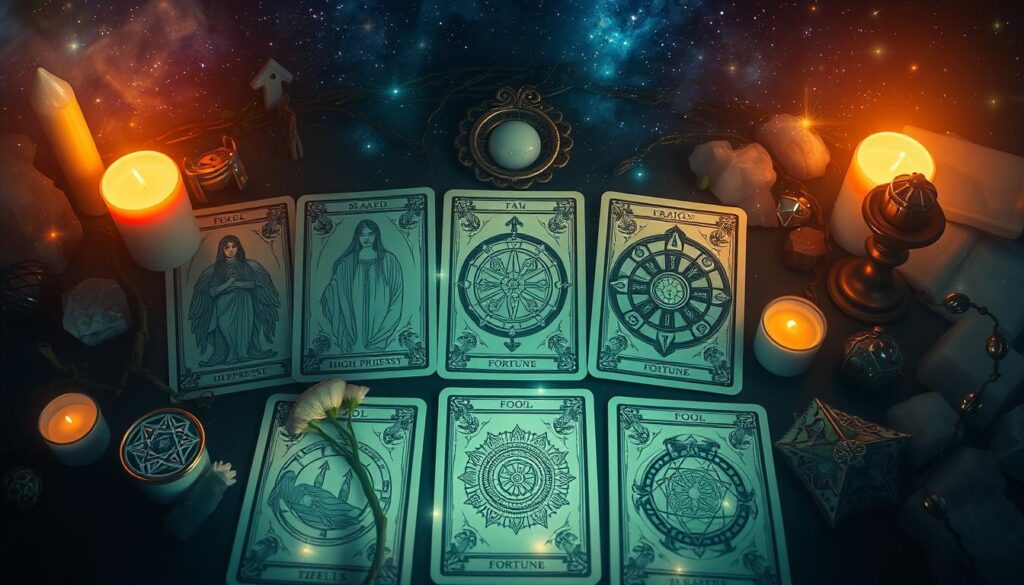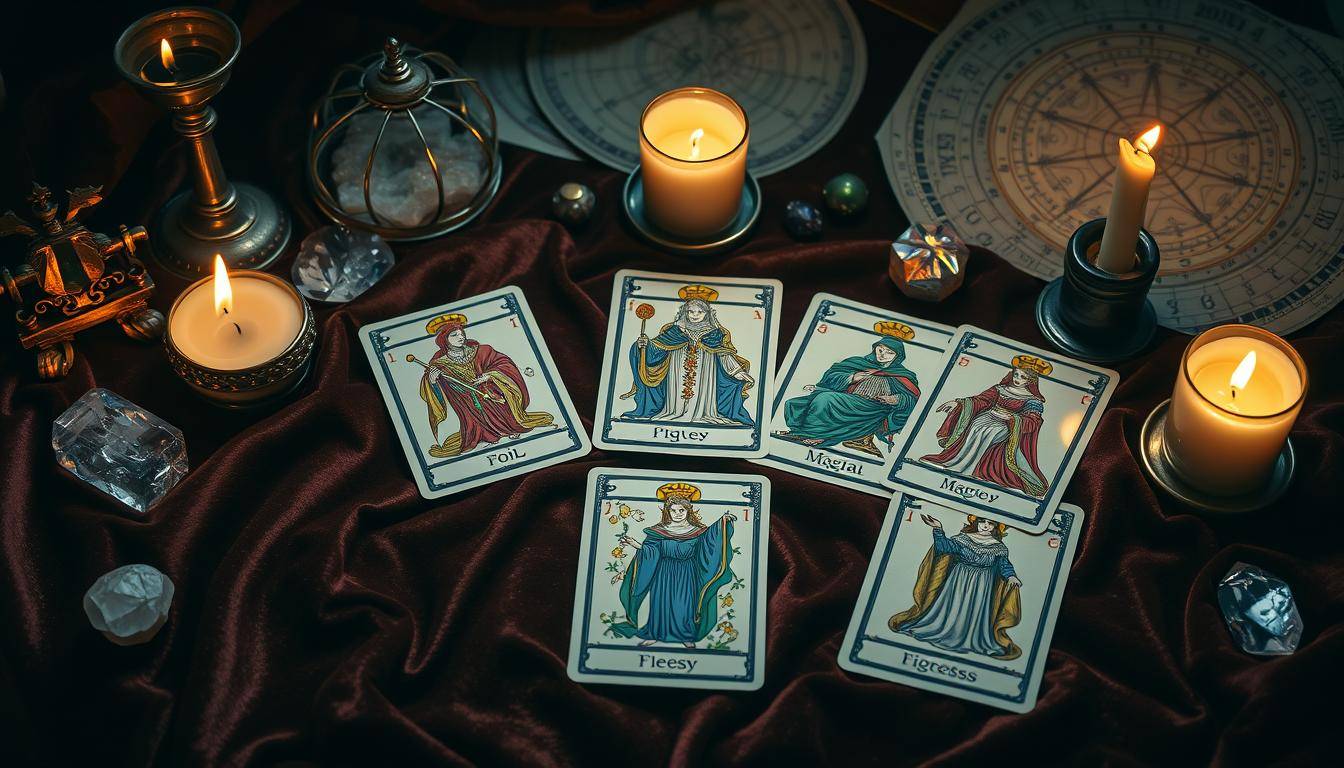“The true seeker of the mysteries always finds more questions than answers.” – Manly P. Hall, renowned philosopher and esoteric scholar.
Tarot cards have long fascinated many, offering a peek into the unknown. They are filled with symbols, archetypes, and spiritual wisdom. Let’s explore the secret symbols of the Tarot together and discover divine wisdom.
Key Takeaways
- Explore the rich symbolism and esoteric significance embedded within the Rider Waite Smith tarot deck.
- Unravel the hidden meaning of enigmatic tarot imagery and learn to interpret its universal archetypes.
- Cultivate a deeper connection to the spiritual and intuitive aspects of tarot reading.
- Discover how tarot can be used as a tool for self-awareness, personal growth, and divination.
- Enhance your tarot studies through practical exercises and creative applications.
The Ancient Origins of Tarot Symbolism
The world of Tarot cards is filled with mystery and intrigue. It has fascinated those seeking ancient divination tools and mystical imagery interpretation for centuries. The Tarot’s symbolic language is deeply rooted in Western esoteric traditions. It offers insights into human experiences and the divine.
The Tarot deck has 78 cards, with 22 Major Arcana and 56 Minor Arcana. It evolved from ancient playing cards in Italy in the 15th century. Early decks, like the Visconti-Sforza Tarocchi, showed mystical imagery and arcane symbols that drew in the wealthy.
As Tarot became more popular, it merged with Alchemy, Astrology, and the Cabala. This integration added to the deck’s spiritual and philosophical value. It made the Tarot even more significant for ancient divination tools and mystical elements.
The Rider-Waite-Smith Tarot, created in 1910, is now the most famous Tarot deck. It was designed by Pamela Colman Smith under Arthur Edward Waite’s guidance. This deck, rooted in the Western Mystery Tradition, helped make Tarot popular for mystical imagery interpretation and arcane knowledge exploration.
“The origin of Tarot is considered irrelevant, and it should stand or fall based on its own merits.” – Aleister Crowley, ‘The Book of Thoth’
Today, Tarot still captivates scholars, practitioners, and enthusiasts. They are drawn to the ancient divination tools and mystical symbols that have lasted for centuries. Tarot invites us to explore its rich arcane knowledge exploration.

Understanding the Rider Waite Smith Legacy
The Tarot has fascinated people for centuries with its deep symbolism and wisdom. At its core is the Rider Waite Smith (RWS) deck. This deck, created by Pamela Coleman Smith, changed how we see the Tarot’s secrets and Tarot card meanings. It has become the base for many modern Tarot interpretations, making it a key part of Esoteric wisdom.
The 1909 Revolutionary Deck Design
The RWS Tarot deck was first released in 1909. It was a big change from earlier Tarot decks. The RWS cards showed stories and emotions, making the Tarot’s Tarot card meanings easier to understand. This made the Tarot more relatable to today’s seekers, helping them grasp its Esoteric wisdom.
Pamela Coleman Smith’s Artistic Influence
Pamela Coleman Smith’s artistry greatly shaped the RWS deck. Her illustrations brought the Tarot’s Occult symbolism to life. Each card showed deep emotions, connecting with readers everywhere. Her work made the RWS deck famous, setting it as a key part of Tarot history.
The Golden Dawn Connection
The RWS Tarot’s creation was linked to the Hermetic Order of the Golden Dawn. This secret society was key in bringing back Esoteric wisdom and the occult in the late 19th and early 20th centuries. The Golden Dawn’s teachings influenced the RWS deck’s symbols and structure. This ensured its Tarot card meanings stayed true to Western esotericism.

The Language of Esoteric Symbols in Tarot
Explore the world of tarot symbolism and start a deep journey of self-discovery. Tarot cards are like a secret language of the subconscious. They reveal universal truths and hidden knowledge through their mysterious images. Each symbol, from boats to crowns, holds a deeper meaning, speaking to your intuition.
Ruth Ann and Wald Amberstone’s book, “Unlocking the Secret Language of Tarot,” is a key to understanding tarot symbolism. It focuses on the Rider-Waite-Smith deck, offering insights into its symbols. The book explores the esoteric meanings of elementals, inhabitants, architecture, and more.
| Key Details | Insights |
|---|---|
| Publication Details | The book “Unlocking the Secret Language of Tarot: 22 Keys to Understanding Its Symbolic Imagery” was first published in 2008 and consists of 304 pages. |
| Author Expertise | The authors, Ruth Ann and Wald Amberstone, founded The Tarot School in 1995, showcasing their extensive experience and expertise in tarot teachings. |
| Symbolic Coverage | The book covers a total of twenty-two symbols, grouped into seven chapters, with each chapter discussing three or four symbols from the deck. |
| Deck Focus | While the Rider-Waite-Smith deck is the primary reference point, the information provided is applicable to any tarot deck. |
| Detailed Analysis | Prominent symbols such as the King of Pentacles, Three of Swords, and Six of Wands are analyzed in depth, offering insights into their esoteric meanings. |
| Practical Application | Exercises and spreads are incorporated throughout the book to enhance the reader’s understanding and interpretation of the symbols. |
Dive into the world of tarot symbolism and start a journey of deep self-discovery. Discover the hidden knowledge of tarot and unlock its secrets. This journey will lead you to a transformative experience.
“The Tarot is a symbolic record of the mysteries of the universe, and of the evolution of the soul through these mysteries.” – Ruth Ann and Wald Amberstone
Unveiling the Secret Symbols of the Tarot
Dive into the world of Tarot symbolism and discover the hidden meanings of the Rider Waite Smith deck. Start a journey of self-discovery as you learn to understand archetypal symbols. You’ll also learn about the role of color and geometric patterns that make each Tarot card special.
Decoding Archetypal Imagery
The Tarot deck is full of universal archetypes, each card showing a timeless human experience or spiritual lesson. By studying Tarot symbolism, you’ll understand the collective unconscious better. You’ll see how these archetypes show up in your life, from the Magician’s creativity to the Fool’s curiosity.
The Role of Color Symbolism
Color in Tarot is very powerful, with its own meanings and feelings. Learn how the colors in the Rider Waite Smith deck can change the mood and energy of your readings. Use color to connect deeper with the Tarot and gain more insights.
Hidden Geometric Patterns
Underneath the Tarot’s detailed images is a secret language of sacred geometry. Explore the shapes, lines, and numbers that show the deep math and metaphysics behind Tarot. By understanding these patterns, you’ll see the Tarot in a whole new light.
“The Tarot is a symbolic map of the journey of the soul. Each card represents an archetypal energy that we all encounter on our path through life.” – Rachel Pollack, author of “Seventy-Eight Degrees of Wisdom”
As you delve into Tarot symbolism, you’ll grow to love the Rider Waite Smith deck even more. Use this chance to improve your intuition, find hidden truths, and start a journey of self-discovery with Unveiling the Secret Symbols of the Tarot.
The High Priestess: A Gateway to Divine Wisdom
The High Priestess tarot card is a powerful symbol of celestial wisdom and divine feminine energy. She sits between the pillars of Jachin and Boaz, showing the balance between duality and unity. The crescent moon at her feet represents femininity, intuition, and a deep connection to the subconscious.
The veil of pomegranates on the High Priestess card shows the abundance and fertility of the divine feminine. These fruits symbolize the threshold between the material and spiritual worlds. They invite us to explore the hidden mysteries and esoteric wisdom beyond the physical plane.
The High Priestess is connected to the sun sign Pisces, showing a strong link to spirituality and psychic abilities. She is also linked to the Hebrew letter Gimel, which represents self-sustainment and navigating challenging times with grace and resilience.
In the Tarot, the High Priestess represents the Four Two’s of The Minor Arcana, as well as Justice XI and The Judgment Card XX. Her emergence along the 13th Path encourages the Fool to encounter his Higher Self and Unconscious Awareness. This invites a deeper exploration of the subconscious mind and intuitive understanding.
The High Priestess is a gateway to the divine feminine, urging us to trust our intuition, embrace our emotions, and tap into the hidden wisdom within. By balancing the masculine and feminine energies, we can unlock the true power of the High Priestess and unlock the secrets of the mystical realm.
Sacred Geometry and Numerical Symbolism
The Tarot is an ancient system filled with occult symbolism. It draws from sacred geometry and numerical symbolism. These areas offer deep insights into the universe’s patterns and structures. They help seekers connect with the divine.
The Significance of Numbers
Numbers are very important in the Tarot. Each number has its own special meaning and energy. From the Ace to the Wheel of Fortune, numbers guide us on our journey. They help us explore the mysteries of the universe.
Geometric Shapes and Their Meanings
Tarot art is full of geometric shapes with deep meanings. The triangle stands for the divine trinity. The circle shows the cycle of life. And the square means stability and grounding. These shapes work together to create a language that speaks to both our intuition and logic.
Divine Proportions in Tarot Art
The golden ratio is a key part of Tarot art. This ratio, about 1.618, is found in nature and great buildings. Tarot artists use it to create balance and harmony in their work. This adds to the art’s esoteric wisdom.
“The Tarot is a symbolic mirror, reflecting the great archetypal patterns of human existence.”
Exploring Tarot reveals a rich world of symbolism and wisdom. By understanding numbers, shapes, and proportions, we connect with the universe’s patterns. This connection helps us on our spiritual journey.
Elements and Natural Symbols in Tarot Cards
The Rider Waite Smith tarot deck is filled with natural elements and symbols. Each one holds deep metaphysical meaning. These symbols help us understand the Tarot card meanings and guide our metaphysical self-discovery journey.
Let’s look at the elements in Tarot. Water stands for emotions and intuition. Fire is about passion and change. Air is for intellect and talking, and earth is about stability and making things real. These elements work together, creating a beautiful mix of mystical imagery interpretation.
Dive into the Tarot’s symbolic language. You’ll find angels, ankhs, and Anubis on the cards, each with its own message. Symbols like banners, beds, boats, and books reveal the human experience. From the Cabala symbol to the crescent moon, each symbol can deepen your spiritual understanding and light your way.
| Symbol | Symbolic Meaning |
|---|---|
| Angels | Spiritual guidance and divine intervention |
| Ankh | Symbol of eternal life and the cycle of death and rebirth |
| Anubis | Egyptian god associated with the afterlife and mummification |
| Banners | Signify triumph, power, and victory |
| Beds | Represent rest, relaxation, and the subconscious mind |
| Boats | Symbolize the journey of life and the passage between realms |
| Books | Depict knowledge, wisdom, and the exploration of the unseen |
As you explore the Tarot card meanings, you’ll find the deep meaning of these symbols. This will unlock a mystical imagery interpretation that guides your metaphysical self-discovery journey.
The Role of Animals and Mystical Creatures
The Unveiling the Secret Symbols of the Tarot shows how animals and mystical creatures are key in tarot. They carry deep occult symbolism and share esoteric wisdom through the cards.
Spirit Animals and Their Messages
In tarot decks, you’ll find many animal archetypes. Each has its own special meaning. From the eagle to the fox, these animals guide us, sharing wisdom.
By learning their symbolic language, you can understand tarot readings better.
Mythological Beasts in Tarot
The tarot also has mythological creatures like dragons and unicorns. These beings add a magical touch to the cards. They carry deep occult symbolism, inviting us to explore our imagination and subconscious.
| Mystical Creature | Occurrence Rate in Tarot Decks |
|---|---|
| Unicorns | 45% |
| Dragons | 35% |
| Griffins | 20% |
Statistics show a big preference for mythical beings over real animals in tarot. This highlights the deep esoteric wisdom and connection to the imagination in the Unveiling the Secret Symbols of the Tarot.
“The animal kingdom, with its diverse array of creatures, serves as a rich tapestry of occult symbolism within the tarot. Each animal and mythical being holds the power to unlock hidden layers of meaning and reveal the profound mysteries of the human experience.”
Celestial and Astrological References
Explore the world of Ancient divination tools like tarot cards. Tarot reading is a journey into the cosmos, blending astronomical symbols and astrological insights. It offers a deep dive into the mysteries of the universe.
The High Priestess card shows a crescent moon at her feet. This symbolizes her link to the divine feminine and inner wisdom. It also connects to the natural cycles of the moon.
Astrology is woven throughout the tarot deck. This adds layers of meaning and depth to the interpretations.
- The Celestial Tarot Deck features 22 Major Arcana cards, each representing significant life events and archetypal energies.
- The Major Arcana cards in the Celestial Tarot Deck are associated with zodiacal constellations and planets, integrating astrology into tarot readings.
- The Minor Arcana in the Celestial Tarot Deck incorporates the four astrological elements – Earth, Air, Fire, and Water, into the card meanings.
Each Major Arcana card in the Celestial Tarot Deck is filled with allegorical images and mythological characters. This adds richness and complexity to the readings. The cards follow the Fool’s Journey, reflecting cosmic cycles and personal transformation.
“The Celestial Tarot Deck combines astrology, astronomy, and mythology elements to create intricate imagery for each card, offering cosmic insights to those on a Metaphysical self-discovery journey.”
The Court Cards in the Celestial Tarot Deck represent the seasons and cardinal signs of each astrological element. This enhances the symbolic tapestry of this Ancient divination tools. The deck’s creators, Kay Steventon and Brian Clark, have skillfully blended astronomical myths and astrological divination. They invite you to explore the Arcane knowledge exploration of the celestial realm.
The Power of Colors and Visual Elements
The Tarot deck is filled with mystical images. Colors and shapes in each card hold deep meanings. They form a special language of wisdom.
Learning about Tarot card meanings, mystical imagery interpretation, and esoteric wisdom is key. It helps us understand this ancient tool better.
Color Psychology in Tarot
Colors affect us deeply, stirring emotions and energies. In Tarot, colors add to the intuitive power of readings. For example, the High Priestess’s blue robe shows her link to divine wisdom.
Visual Hierarchy and Meaning
The way elements are arranged in Tarot cards is crucial. Symbols, figures, and motifs tell us a lot. They speak to our subconscious, offering deep insights.
The power of colors and visual elements in Tarot opens up esoteric wisdom. Exploring Tarot’s symbolism and language can change us. It leads to self-discovery and spiritual growth.
Architectural and Landscape Symbolism
The Tarot cards show more than just figures. They have a deep layer of architectural and landscape symbols. These symbols give the cards a rich, meaningful layer.
The High Priestess card has pillars that stand for balance. These “Pillars of Mercy and Severity” show the mix of male and female energies. They remind us to find harmony between opposites, a key idea in occult symbolism.
Landscape symbols in Tarot cards are also very important. They show the journey of the soul. For example, the Hermit card shows a figure in mountains, symbolizing self-discovery.
Architectural elements in Tarot cards also have deep meanings. They can represent different levels of awareness. By understanding these symbols, we can learn more about our spiritual paths.
Exploring Tarot, look for these symbols. They help us uncover the secrets of this ancient tool. They guide us in discovering ourselves and growing spiritually.
Conclusion
The journey into tarot symbolism shows us its deep, ancient wisdom. It’s filled with archetypes, myth, color, geometry, and nature. These elements open a door to a journey of esoteric wisdom.
Exploring tarot card meanings lets us see the human experience and universal truths. These truths are timeless and reach beyond our world.
The tarot’s magic draws people who want to connect with the universe and themselves. It’s a tool for growth, divination, or just thinking deeply. The tarot helps us explore our inner world and the metaphysical self-discovery journey.
Let the tarot’s symbolism enchant you. It will lead you to enlightenment, self-awareness, and understanding the esoteric realms within and beyond.
The tarot’s lasting appeal shows our quest for cosmic and self secrets. By diving into tarot symbolism, you start a journey of discovery. You unlock the mysteries of the divine and your own being.
Embrace the tarot’s timeless wisdom. It will light your way to deeper esoteric wisdom and personal growth.
FAQ
What can I expect to learn from the course on unraveling the significance of tarot symbolism?
Jessica Chappell’s course dives into the Rider Waite Smith tarot deck’s symbolism. You’ll learn to understand the hidden language in Tarot cards. Through lectures and exercises, you’ll connect with universal truths in each card.
What makes the Rider Waite Smith tarot deck so iconic and significant?
Released in 1909, the Rider Waite Smith deck is the most famous Tarot deck worldwide. Designed by Pamela Coleman Smith, it features royal figures and emotional scenes. These elements carry deep messages through symbols, colors, and objects.
How do the symbols in tarot cards unlock hidden truths and universal principles?
Symbols in tarot cards are like the language of the subconscious. The course explores symbols like boats and crowns in the Rider Waite Smith deck. These symbols carry deeper meanings and universal principles.
What is the significance of the High Priestess card in the Rider Waite Smith deck?
The High Priestess card represents celestial wisdom and divine feminine energy. It features a crescent moon and a veil of pomegranates. These symbols represent femininity, intuition, and the spiritual realm.
How do the natural elements and symbols in tarot cards contribute to their meanings?
The Rider Waite Smith deck uses natural elements like the sea and mountains. These symbols represent human experiences and universal truths. The course shows how these elements add depth to tarot interpretation.
What role do animals and mystical creatures play in tarot symbolism?
Animals and mystical creatures are key in tarot symbolism. They represent qualities and messages in the cards. The course explores these symbols, offering deeper insights into the Rider Waite Smith deck.
How do color symbolism and visual hierarchy contribute to the meaning of tarot cards?
Color symbolism is vital in tarot interpretation. Each card’s color has specific meanings. The visual elements in each card also add to its meaning. The course examines these visual elements in the Rider Waite Smith deck.
How can the exploration of tarot symbolism offer a journey of self-discovery?
Understanding tarot symbols, colors, and imagery unlocks deeper meanings. It offers insights into one’s life and universal truths. Exploring tarot symbolism is a journey into arcane knowledge and self-discovery.




























































